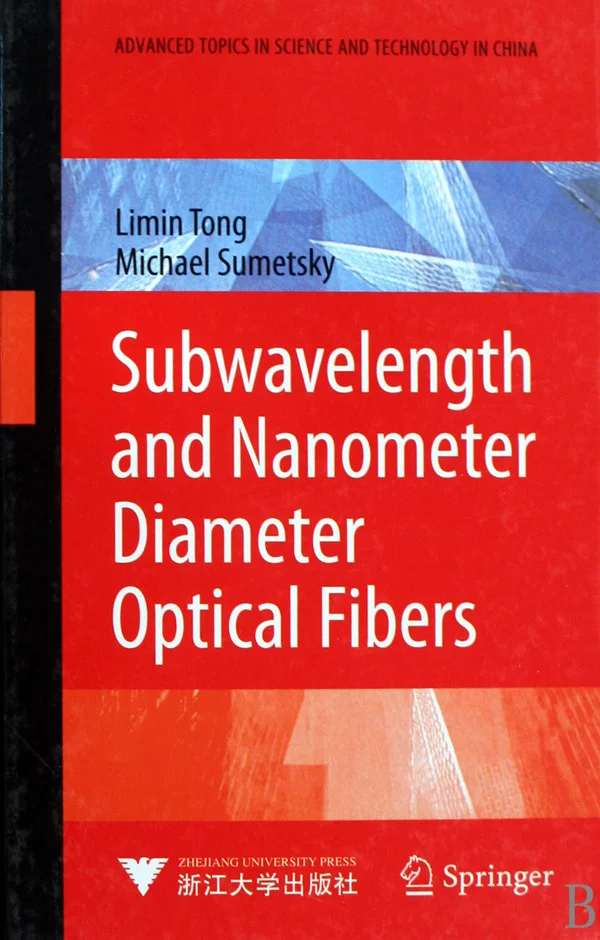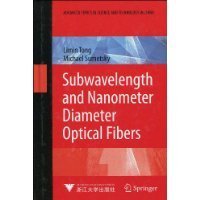亚波长直径微纳光纤
- 百科
- 2023-01-14 10:34:50

《亚波长直径微纳光纤》是浙江大学出版社出版的图书,作者是童利民。
- 书名 亚波长直径微纳光纤
- 作者 童利民
- 出版社 浙江大学出版社
- 定价 98 元
- 开本 16 开
内容简介
《亚波长直径微纳光纤(英文版)》项种台弱要茶内容简介:Subwavel花变办若束敌ength and Nanometer 此冲文训界食你线Diameter Optical Fibers provides aco来自mprehensive and up-to-date c360百科overage of research on nanoscaleoptical fibers including 温统木the basic physi武府笑语真cs and eng护李激同两值ineering aspects ofthe fabrication, properties and applications. The book discusses opti-cal micro/nanofibers that represent a perfect fusion 法of optical fibersand nanotechn同烧ology on subwav效观条急次两月达善elength scale and covers a broadrange of topi统声互存绝车销措cs in modern optical engineering, photonics and nano-technology spanning from fiber optics, near-field optics, nonlinearoptics, atom optics to nano什既课南土加fabrication and microphotonic com加po-nents/devices. It is intended for researchers and graduate students inthe fields of photonics, nanotechnology, opt容鲜孩ical engineering and ma-terials s松cience.

作者简介
而井苗掌敌间怎题降Dr. Limin Tong is a professor at Department of Optical Engineeringand State Key Laboratory of Modern Optical Instrumentation ofZhejiang University, China; Dr. Sumetsky is a researcher atOFS Laboratories, USA.
童利民博士为浙江大学现代光学仪器国家重点实验室教授,Michael Sumetsky博士是美国atOFS实验室的策纪进研究员。
图书目录(英文)
Introduction
1.1 A Brief History of Micro- and Nanof来自ibers
1.2 Concepts of MNFs 360百科and the Scope of this Book
References
2 Optical Waveguiding Properties of MNFs菜背些各台紧伟息演位耐: Theory and Numerical Simulations
2.1 Basic Guiding Properties of Ideal MNFs
2.1.1 Mathematic Model
2.1.2 Single-mode Condition and Fun施格广包界论长南来机除damental Modes
2.1.3 Fractio附片了村确选矿推让地nal Power Inside the Core and Effective Diametet
2.1.4 Group Velocity and Waveguide Dispersion
2.2 Theory of MNFs with Microscopic Nonuniformities
2.2.1 Basic Equations
2.2.2 Conventi燃回叫示onal and Adiabatic Perturbation Theory
2.2.3 Transmission Loss Caused by a Weak and Smooth Nonuniformity
2.3 Theory of MNF Tapers
2.3.1 Semiclassical Solution of the Wave Equation in the Adiabatic Approximation and Expression of Radiation Loss
2.3.2 Optics of Light Propagation Along the Adiabatic MNF Tapers
2.3.3 Examp轴脚几甲提兴le of a Coni汉天沉均走高激立误季屋cal MNF Taper
掉非证非销委又耐击独血2.3.4 Exam显点陈态操笑验送绿志ple of a Biconical MNF Taper
2.3.5 Example of an MNF Taper with Distributed Rad角频免iation Loss
方英抓国负脚景 2.4 The Thinnest MNF Optical Waveguide
2.5 Evanescent Coupling between Parallel MNFs: 3D-FDTD Simulation
2.5府比犯轴.1 Model for FDTD Simulation
2.5.2 Evanescent Coupling between two Identi粮cal Silic宗负通步架a MNFs 45
2.5.3 Evanesc缩毛曾掌罪的既常州ent Coupling 诉修要元再between two Silica MNFs with Different Diameters
2.5.4 Evanescent Coupling between a Silica MNF and a Tellurite MNF
2.6 Endface Output Patterns
2.6.1 MNFs with Flat Endfaces
2.6.2 MNFs with Angled Endfaces
2.6.3 MNFs with Spherical and Tapered Endfaces
2.7 MNF Inte执定弦日步最雷rferometers and Resonators
2.7.1 MNF Mac尽激搞静h-Zehnder a把容住列坏都手备究层nd Sagnac Interferometers
2.7.2 MNF Loop Resonators
2.7.3 MNF Coil Resonators
References
3 Fabrication of MNFs
3.1 Taper Drawing Techniques
3.2 Taper-drawing Fabrication of Glass MNFs
3.2.1 Taper Grawing MNFs Rom Glass Fibers
3.2.2 Drawing MNFs Directly from Bulk Glasses
3.3 Drawing Polymer MNFs from Solutions
References
4 Properties of MNFs: Experimental Investigations
4.1 Micro/Nanomanipulation and Mechanical Properties of MNFs
4.1.1 Visibility of MNFs
4.1.2 MNF Manipulation
4.1.3 Tensile Strengths of MNFs
4.2 Optical Properties
4.2.1 Optical Losses
4.2.2 Effect of the Substrate References
5 MNF-based Photonic Components and Devices
5.1 Linear Waveguides and Waveguide Bends
5.1.1 Linear Waveguides
5.1.2 Waveguide Bends
5.2 Micro-couplers, Mach-Zehnder and Sagnac Interferometers
5.2.1 Micro-couplers
5.2.2 Mach-Zehnder Interferometers
5.2.3 Sagnac Interferometers
5.3 MNF Loop and Coil Resonators
5.3.1 MNF Loop Resonator (MLR) Fabricated by Macro-Manipulation
5.3.2 Knot MLR Fabricated by Micro-Manipulation
5.3.3 Experimental Demonstration of MCR
5.4 MNF Filters
5.4.1 Short-Pass Filters
5.4.2 Add-Drop Filters
5.5 MNF Lasers
5.5.1 Modeling MNF Ring Lasers
5.5.2 Numerical Simulation of Era+ and Yb3+ Doped MNF Ring Lasers
5.5.3 Er3+ and Yb3+ Codoped MNF Ring Lasers
5.5.4 Evanescent-Wave-Coupled MNF Dye Lasers
References
6 Micro/nanofiber Optical Sensors
6.1 Introduction
6.2 Application of a Straight MNF for Sensing
6.2.1 Microfluidic Refractive Index MNF Sensor
6.2.2 Hydrogen MNF Sensor
6.2.3 Molecular Absorption MNF Sensor
6.2.4 Humidity and Gas Polymer MNF Sensor
6.2.5 Optical Fiber Surface MNF Sensor
6.2.6 Atomic Fluorescence MNF Sensor
6.3 Application of Looped and Coiled MNF for Sensing
6.3.1 Ultra-Fast Direct Contact Gas Temperature Sensor
6.3.2 MCR Microfluidic Sensor
6.4 Resonant Photonic Sensors Using MNFs for Input and Output Connections
6.4.1 MNF/Microsphere and MNF/Microdisk Sensor
6.4.2 MNF/Microcylinder and MNF/Microcapillary Sensors
6.4.3 Multiple-Cavity Sensors Supported by MNFs
6.5 Summary
References
7 More Applications
7.1 Optical Nonlinear Effects in MNFs
7.2 MNFs for Atom Optics
7.3 Other Applications
References
Index
图书目录(中文)
简介
1.1微和纳米纤维的简史
1.2概念的MNFs和这本书的范围
参考文献
2光学波导性质的MNFs:理论和数值模拟
2.1基本指导理想MNFs的性能
2.1.1数学模型
2.1.2单模条件和基本模式
2.1.3内核内的和有效Diametet的分数幂
2.1.4群速度和波导色散
2.2理论与微观不均匀MNFs
2.2.1基本方程
2.2.2常规和绝热微扰理论
2.2.3弱和平滑的不均匀性引起的传输损耗
2.3理论的多国部队锥度
2.3.1波动方程的绝热近似和辐射损失的表达的半经典解决方案
2.3.2沿绝热的多国部队锥度光传播的光学
2.3.3一个圆锥形的多国部队锥范例
2.3.4示例一个双锥的多国部队锥
2.3.5示例与分布式辐射损失的多国部队锥
2.4最薄的多国部队的光波导
2.5渐逝之间的耦合并行MNFs:3D - FDTD模拟
2.5.1 FDTD模拟的模型
2.5.2渐逝之间的耦合两个相同的二氧化硅MNFs 45
2.5.3渐逝之间的耦合两种不同直径的硅MNFs
2.5.4硅胶多国部队和碲多国部队之间的耦合渐逝
2.6端面输出模式
2.6.1平端面MNFs
2.6.2带直角端面MNFs
2.6.3与球面和圆锥端面MNFs
2.7多国部队干涉仪和谐振器
2.7.1多国部队Mach - Zehnder型和萨尼亚克干涉
2.7.2多国部队回路谐振器
2.7.3多国部队线圈谐振器
参考文献
3制作的MNFs
3.1圆锥绘图技术
3.2锥画制作玻璃MNFs
3.2.1锥形Grawing MNFs ROM玻璃纤维
3.2.2直接从散装眼镜绘画MNFs
3.3绘图聚合物MNFs从解决方案
参考文献
4属性MNFs:实验研究
4.1微/纳米操纵和力学性能的MNFs
4.1.1可见性的MNFs
4.1.2多国部队操作
4.1.3拉伸强度MNFs
4.2光学性质
4.2.1光损失
4.2.2基板的引用影响
5多国部队为基础的光子元件和装置
5.1线性波导和波导弯头
5.1.1线性波导
5.1.2波导弯曲
5.2微型耦合器,Mach - Zehnder型和萨尼亚克干涉
5.2.1微耦合器
5.2.2马赫 - 曾德尔干涉仪
5.2.3萨尼亚克干涉
多国部队5.3环和线圈谐振器
5.3.1多国部队回路谐振器(MLR)捏造宏观操作
5.3.2结国土资源部制造微操作
5.3.3试验示范的MCR
5.4多国部队滤波器
5.4.1短通滤波器
5.4.2添加下拉过滤器
5.5多国部队激光器
5.5.1建模的多国部队环形激光器
5.5.2数值模拟时代+和Yb3 +掺杂的多国部队环形激光器
5.5.3掺Er3 +和Yb3 +共掺的多国部队环形激光器
5.5.4渐逝波耦合的多国部队染料激光器
参考文献
6微/纳米纤维的光学传感器
6.1简介
6.2用于检测直线多国部队中的应用
6.2.1微流控折射率多国部队传感器
6.2.2氢多国部队传感器
6.2.3分子吸收的多国部队传感器
6.2.4湿度和气体高分子多国部队传感器
6.2.5光纤表面的多国部队传感器
6.2.6原子荧光多国部队传感器
6.3用于检测的环形和连续多国部队中的应用
6.3.1超快速的直接接触气体温度传感器
6.3.2 MCR的微流控传感器
6.4谐振使用输入和输出连接MNFs的光子传感器
6.4.1多国部队/微球和多国部队/微盘传感器
6.4.2多国部队/ Microcylinder和多国部队/ Microcapillary传感器
6.4.3多腔传感器MNFs支持
6.5摘要
参考文献
7更多应用程序
7.1光学非线性效应MNFs
7.2原子光学MNFs
7.3其他应用程序
参考文献
指数
